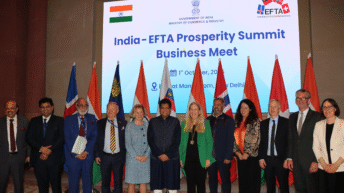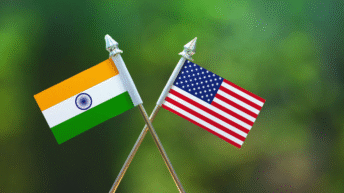
Besides signing a slew of 28 trade and investment deals, Russia, during the 2+2 meeting on 6th of December in New Delhi, has agreed to continue exporting the S-400 missile defence system to India. Reporting the event the New York Times wrote, “India’s purchasing of a $ 5.4 billion missile defence system from Russia, signalled that it was more worried about an emboldened China at its borders than about angering the United States.”
The core of the issue is what will be the impact on India and the democratic world if the world’s strongest democracy (the US) decides to impose sanctions on the world’s largest democracy (India) when the latter has the compulsion of bolstering its security against a totalitarian regime.
Sino-Pak angle
After illegally grabbing a large part of the Indian State of Jammu and Kashmir through mercenaries in 1947, Pakistan covets the entire territory of the state on the basis of commonality of religion. Pakistan-based “non-state actors’ fighting a proxy war against Indian security forces in Kashmir have become the instrument for spreading Islamic Theo-fascism in the region. Pakistan is trying to cover up the atrocities. Its irregulars commit through Goebbelsian propaganda. The comment of the former Pakistani President Ziau’l Huq on his ‘Operation Topac’ (Kashmir annexation) plan is revealing; “Pakistan will inflict a thousand cuts on India’s body to bleed it white.”
China fosters a bitter rivalry with India. She believes India is the only regional power capable of throwing a challenge to her dominance over the Asian Continent. The biggest threat which China and Pakistan both imagine lying in the rise of India is the latter’s deepening democratic dispensation. Therefore, adversaries will do all they can to obstruct India’s march to a position of influence. China is obstructing India’s claim to a permanent seat in the UN Security Council.
The alarming situation for India is that China is steadily building its military power. along the LAC in Ladakh region, together with introducing a new scheme for setting up new border villages along the LAC. China is also expanding its naval presence in the Indian Ocean Region.
In the spirit of upholding the Chanakyan and Maoist dictum of “enemy’s enemy is a friend” China is holding Pakistan in a tight bear hug. The two military states are also familiar with bullying and sword-rattling tactics besides sharing a known aversion to liberal democratic governance. They call themselves “iron brothers” and are geopolitically engaged in encircling India with the “necklace of pearls” as China puts it.
India’s assessment
India foresees a threat from the Sino-Pak unholy alliance on the background of two possibilities. One is that China has a comprehensive programme of spreading a network of road and rail connectivity all along the northern border of India, facilitated by Pakistan acquiescing to Beijing’s diktat. This endangers India’s security. The second is the militarization of the Indian Ocean and the control of trading channels particularly the narrow but strategic Strait of Malacca through which much of world trade flows. Both threat perceptions demand that India should become militarily strong to face the double challenge; one on the land and the other on the sea. It is this unavoidable necessity that makes India prioritise her defence requirements.
This brings us to the crux of the problem. Security-wise, India has identified three sectors that need to be converted into bulwarks against any foreign aggressive design. These are (a) the Sino-Indian sector from Siachin to Arunachal (b) the Indo-Pak border sector from Daulatbeg Oldi in the Karakoram down to Barmer in Rajasthan and (c) the Indian Ocean Region (IOR). This implies that virtually the entire land and oceanic border line of India has to be taken care of.
In view of the belligerent Sino-Pak camaraderie, India has geared up her defence preparedness. She has signed defence procurement deals with France, the US, Israel and Russia to acquire upgraded military hardware required by the three defence services.
India also has a strategic partnership with the US. She has also joined the Quad which is an agreement between the US, India, Japan and Australia — the four principal stakeholders in the Indo-Pacific. Apart from expanding their trade relations, Quad countries are also committed to maintaining the freedom of navigation in the said region. South-East Asian countries like Vietnam, Indonesia, Malaysia, Brunei, and the Philippines often complain of China encroaching on their sovereign territories and Exclusive Economic Zones (EEZs). Chinese war ships get menacingly close to the Australian shores. Countries like India and the United States also have stakes in securing the South China Sea — an endowed ecosystem that is home to rich biodiversity and varied resources, including an estimated 190 trillion cubic feet of natural gas and 11 billion barrels of oil in proved and probable reserves, most of which lie along the margins of the South China Sea, under disputed islets and reefs although other resources may still be undiscovered.
Given this security scenario India felt it should have a missile shield like other powerful countries to ensure protection against threats posed by two hostile neighbours. Recently China has given Pakistan its largest and the most advanced warship and also upgraded the Gwadar port in the Gulf of Oman. Pakistan has deployed Nasr ballistic missiles close to the Indian border. India did examine the American and Israeli option but ultimately focused on S-400 as the most effective system to meet its requirements. The agreement between India and the Russian Federation was signed in 2018. The delivery has already begun..
The US culls reasons for obstructing the deal. Firstly, the 2017 American law of Countering America’s Adversaries through Sanctions Act (CAATSA) provides for punitive actions against any country engaged in transactions with Russian defence and intelligence sectors. Secondly, the warnings to Delhi stem from an operational decision to protect its advanced platforms from being technically snooped upon by the S-400. Thirdly, these threats stem from Washington’s displeasure over the Indian Air Force opting for the S-400 instead of rival systems like Lockheed Martin’s Patriot Advanced Capability-3 or PAC-3 or the analogous Terminal High Altitude Area Defence (THAAD) systems. And lastly the Americans have a wider goal to penalise Moscow for its actions in Crimea and Ukraine.
A major part of India’s military hardware is Russian made. Russia twice used her veto power to scuttle anti-India resolutions in the Security Council. No doubt, there was a souring of bilateral relations soon after Russia’s debacle in the Afghan war and the disbandment of the USSR but the bonds between India and Russia are too deep to be disrupted by transient events. President Putin’s recent visit to New Delhi and signing of no fewer than 28 agreements relating to energy, technology, trade and commerce, defence, Afghanistan and a host of matters should give an indication of how much importance Russia attaches to India.
Implications
The Biden Administration has hinted those sanctions could be imposed on India under the US 2017 Law as in the case of Turkey. The question is will the US run the risk of alienating India at a time when China is challenging her military and economic superiority? There are conflicting views among lawmakers whether imposition of sanctions on the world’s largest democracy by the world’s oldest democracy will strengthen the philosophy of democracy? Many leaders of the European Union’s member nations are unhappy over such a decision. In a letter to Biden, Senators Mark Warner of the Democratic Party and John Cornyn of the Republican Party urged the president to grant a national interest waiver to India as provided under CAATSA as this is in America’s national security interest.
Imposing sanctions means bringing New Delhi under great domestic pressure for parting ways with the Quad. Simultaneously, the Indo-Pacific security concept also becomes vulnerable. India’s withdrawal from Quad will upset the security arrangements of Australia, and Japan besides being a major disappointment to the island states of the South China Sea. It will be a temptation for Beijing to fill the vacuum.
It will be a big mistake for Washington to think that India is another Iran. Sanctioning India makes a dent in the American strategic posture in the Indo-Pacific and SCS which is likely to give a strong boost to Indo-Russian regional strategic cooperation. The China sponsored Quad (China, Pakistan, Iran and Turkey) will be emboldened and Russia will emerge as the decisive power in the Indian Ocean Region. The South East Asian countries like Vietnam, Cambodia and the Philippines etc. will be forced to revisit their defence strategy and evaluate their options. Realignments of vast scale, if thrust upon the states of SCS, will have a far-reaching impact on contemporary world politics.
Conclusion
At a time when President Biden has invited more than a hundred country heads for discussing ways of strengthening democratic dispensation world over, it will be paradoxical to impose sanctions on India, for the sin of streamlining her defence and security arrangement. As the world’s largest democracy India should make a big effort to convince the American people and their lawmakers that the strength of a democracy lies in allowing it to thrive according to its local ecosystem.






Add comment